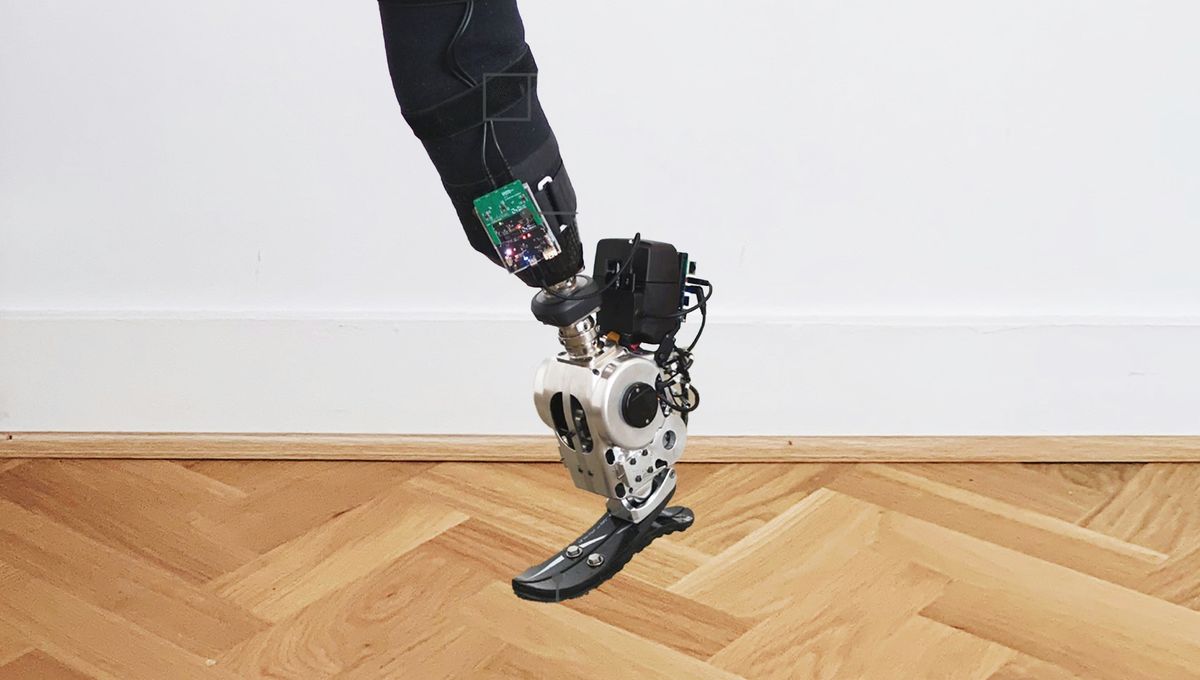
A new robotic ankle controlled by electrical signals in residual muscles below the knee is showing promise in improved mobility and reduced pain. After just two practice sessions, around six hours in total, seven participants in a clinical trial testing the new device were able to walk as fast as non-amputees and the movements of their bionic joint mimicked natural ankle movements.
Walking is easy, when you don’t have to think about it. In reality, controlling an action seemingly as simple as walking is not just a question of contracting the right muscles. It is a complex choreography of control and feedback.
When you decide to take a step, your brain sends signals down your spinal cord and into your legs, telling the muscles to contract, bending your joints. The movement and position of each joint is controlled by the contrasting action of two types of muscles: agonists and antagonists.
Think about your arm. When you flex your elbow, your biceps acts as the agonist contracting and bringing your forearm closer to your upper arm. At the same time, your triceps (on the other side of the arm), the antagonist in this movement, is relaxing and allowing the movement to happen. Conversely, when you stretch your arm, your triceps acts as the agonist pulling the forearm away and the biceps is the antagonist relaxing its pull.
By reading out the tension in both the biceps and the triceps your brain can figure out at what angle your elbow is bent. The ability to perceive this tension is called proprioception: the perception of yourself (proprio in Latin). This then informs your motor system.
When you contract your leg muscles to walk, you bend the joints in your hip, knee, and ankle. The position of each of these joints at the start and end of the step, and the resistance each movement might meet, is different when you walk in all types of situations (dodgy terrains, slopes, sticky mud). This makes it impossible for the brain to just send a one-size-fits-all “walk” command.
Walking is a lot to think about
Leg amputees have lost a lot of their muscles, and both the nerves that control muscle contraction as well as the proprioceptive ones that send feedback about how the movement is going. Developments in prosthetic limbs are trying to restore the full orchestra of commands and feedback.
In early prosthetics, patients could control their limb with a body-powered harness: e.g. they would learn to move their shoulder to control their prosthetic hand. Then, more sophisticated prostheses came along that used electrical signals in the muscles of the upper leg to steer ankle joint movements.
Until now, feedback signals were not being utilized, resulting in movements that were less flexible and unable to adapt to a changing environment.
A new type of leg prosthesis is now promising smoother walking: the agonist-antagonist myoneural interface (AMI). That’s a mouthful. The AMI restores proprioceptive signaling by reconnecting the agonist and antagonist muscles. The brain and the device can then read out the complementary tension in the two muscles, the same way we do with our biceps and triceps.
The first prosthetic of this type is a bionic ankle for people with amputations below the knee where the muscles of the shin and the calf can be reattached. Because the agonist and antagonist are connected again, the bending of the joints can be read out by the opposing tension in the two muscles. This tension adapts to various situations, like inclined terrain and stairs.
A decoder in the prosthesis can dynamically adjust the ankle flexion, the way that an intact limb would. The range of ankle movements in the prosthesis during walking was strikingly similar to that of non-amputees.
So, what’s next for prosthetic legs? Osseoperception. The authors point to research that shows improved integration of prosthetics when they are anchored to the bone (ossum in Latin). Bionic limbs are getting closer and closer not only to moving like a biological limb, but to feeling like one too.
The study is published in Nature Medicine.
Source Link: Smooth Walking Isn't Easy, But This State-Of-The-Art Bionic Ankle Can Do It